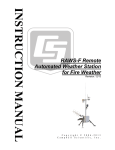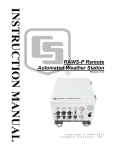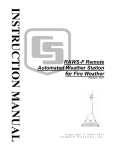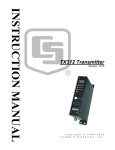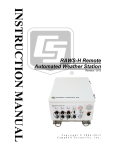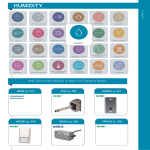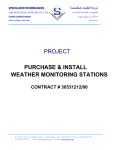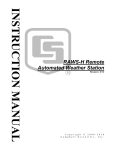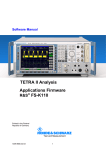Download Campbell RAWS-P Product manual
Transcript
RAWS-P Remote Automated Weather Station Revision: 12/13 C o p y r i g h t © 2 0 0 6 - 2 0 1 3 C a m p b e l l S c i e n t i f i c , I n c . Warranty “PRODUCTS MANUFACTURED BY CAMPBELL SCIENTIFIC, INC. are warranted by Campbell Scientific, Inc. (“Campbell”) to be free from defects in materials and workmanship under normal use and service for twelve (12) months from date of shipment unless otherwise specified in the corresponding Campbell pricelist or product manual. Products not manufactured, but that are re-sold by Campbell, are warranted only to the limits extended by the original manufacturer. Batteries, fine-wire thermocouples, desiccant, and other consumables have no warranty. Campbell’s obligation under this warranty is limited to repairing or replacing (at Campbell’s option) defective products, which shall be the sole and exclusive remedy under this warranty. The customer shall assume all costs of removing, reinstalling, and shipping defective products to Campbell. Campbell will return such products by surface carrier prepaid within the continental United States of America. To all other locations, Campbell will return such products best way CIP (Port of Entry) INCOTERM® 2010, prepaid. This warranty shall not apply to any products which have been subjected to modification, misuse, neglect, improper service, accidents of nature, or shipping damage. This warranty is in lieu of all other warranties, expressed or implied. The warranty for installation services performed by Campbell such as programming to customer specifications, electrical connections to products manufactured by Campbell, and product specific training, is part of Campbell’s product warranty. CAMPBELL EXPRESSLY DISCLAIMS AND EXCLUDES ANY IMPLIED WARRANTIES OF MERCHANTABILITY OR FITNESS FOR A PARTICULAR PURPOSE. Campbell is not liable for any special, indirect, incidental, and/or consequential damages.” Assistance Products may not be returned without prior authorization. The following contact information is for US and international customers residing in countries served by Campbell Scientific, Inc. directly. Affiliate companies handle repairs for customers within their territories. Please visit www.campbellsci.com to determine which Campbell Scientific company serves your country. To obtain a Returned Materials Authorization (RMA), contact CAMPBELL SCIENTIFIC, INC., phone (435) 227-9000. After an application engineer determines the nature of the problem, an RMA number will be issued. Please write this number clearly on the outside of the shipping container. Campbell Scientific’s shipping address is: CAMPBELL SCIENTIFIC, INC. RMA#_____ 815 West 1800 North Logan, Utah 84321-1784 For all returns, the customer must fill out a “Statement of Product Cleanliness and Decontamination” form and comply with the requirements specified in it. The form is available from our web site at www.campbellsci.com/repair. A completed form must be either emailed to [email protected] or faxed to (435) 227-9106. Campbell Scientific is unable to process any returns until we receive this form. If the form is not received within three days of product receipt or is incomplete, the product will be returned to the customer at the customer’s expense. Campbell Scientific reserves the right to refuse service on products that were exposed to contaminants that may cause health or safety concerns for our employees. Table of Contents PDF viewers: These page numbers refer to the printed version of this document. Use the PDF reader bookmarks tab for links to specific sections. 1. Introduction .................................................................1 2. Getting Started ............................................................2 3. Station Siting and Orientation ...................................5 3.1 3.2 3.3 3.4 3.5 3.6 3.7 General Description .............................................................................5 Air Temperature and Relative Humidity..............................................5 Precipitation .........................................................................................6 Solar Radiation.....................................................................................6 Wind Speed and Direction ...................................................................6 Barometric Pressure .............................................................................6 Fuel Moisture and Fuel Temperature ...................................................6 4. Sensor Wiring and Troubleshooting.........................6 4.1 4.2 4.3 4.4 4.5 4.6 Air Temperature and Relative Humidity..............................................6 4.1.1 General Description ......................................................................6 4.1.2 Wiring ...........................................................................................7 4.1.3 Troubleshooting ............................................................................7 Rain Gage.............................................................................................7 4.2.1 General Description ......................................................................7 4.2.2 Wiring ...........................................................................................7 4.2.3 Troubleshooting ............................................................................8 Solar Radiation.....................................................................................8 4.3.1 General Description ......................................................................8 4.3.2 Wiring ...........................................................................................8 4.3.3 Troubleshooting ............................................................................8 Wind Speed and Direction ...................................................................9 4.4.1 Wind Sensor..................................................................................9 4.4.1.1 General Description............................................................9 4.4.1.2 Wiring ................................................................................9 4.4.1.3 Troubleshooting .................................................................9 4.4.2 2-D WindSonic ...........................................................................10 4.4.2.1 General Description..........................................................10 4.4.2.2 Wiring ..............................................................................10 4.4.2.3 Troubleshooting ...............................................................10 Barometric Pressure ...........................................................................10 4.5.1 General Description ....................................................................10 4.5.2 Wiring .........................................................................................11 4.5.3 Troubleshooting ..........................................................................11 Fuel Moisture and Fuel Temperature .................................................11 4.6.1 General Description ....................................................................11 4.6.2 Wiring .........................................................................................12 4.6.3 Troubleshooting ..........................................................................12 i Table of Contents 5. Equipment Wiring and Troubleshooting.................12 5.1 5.2 5.3 5.4 5.5 5.6 Solar Panels ....................................................................................... 12 5.1.1 General Description.................................................................... 12 5.1.2 Wiring ........................................................................................ 13 5.1.3 Troubleshooting ......................................................................... 13 Charger/Regulator ............................................................................. 13 5.2.1 General Description.................................................................... 13 5.2.2 Wiring ........................................................................................ 14 5.2.3 Troubleshooting ......................................................................... 15 Battery ............................................................................................... 15 5.3.1 General Description.................................................................... 15 5.3.2 Wiring ........................................................................................ 15 5.3.3 Troubleshooting ......................................................................... 16 GOES Transmitter ............................................................................. 16 5.4.1 General Description.................................................................... 16 5.4.2 Wiring ........................................................................................ 17 5.4.3 Troubleshooting ......................................................................... 18 CR1000 Keyboard/Display ............................................................... 18 5.5.1 General Description.................................................................... 18 5.5.2 Wiring ........................................................................................ 19 5.5.3 Troubleshooting ......................................................................... 19 CR1000 Datalogger ........................................................................... 19 5.6.1 General Description.................................................................... 19 5.6.2 Wiring ........................................................................................ 20 5.6.3 Troubleshooting ......................................................................... 20 6. Desiccant ...................................................................20 7. Sensor and Equipment Maintenance ......................20 8. References.................................................................21 9. RAWS Orientation .....................................................21 9.1 9.2 Determining True North and Sensor Orientation .............................. 21 USGS Web Calculator....................................................................... 24 1-1. 2-1. 5-1. 5-2. 5-3. 5-4. 5-5. 9-1. 9-2. Color coded, keyed connector panel.................................................... 1 Inside environmental enclosure (optional equipment shown) ............. 3 12 volt charger/regulator ................................................................... 14 GOES transmitter .............................................................................. 17 CR1000 keyboard/display ................................................................. 18 CR1000 and printed circuit wiring panel........................................... 19 Printed circuit board wiring panel connector ID ............................... 20 Magnetic declination for the contiguous United States ..................... 22 A declination angle east of True North (positive) is subtracted from 360 (0) degrees to find True North........................................ 23 A declination angle west of True North (negative) is subtracted from 0 (360) degrees to find True North........................................ 23 USGS web calculator ........................................................................ 24 Figures 9-3. 9-4. ii Table of Contents Tables 2-1. 4-1. 4-2. 4-3. 4-4. 4-5. 4-6. 4-7. 5-1. Public Variables ...................................................................................4 TEMP/RH Connector (color coded orange).........................................7 PRECIP Connector (color coded blue) ................................................7 SOLAR RAD SDI-12 Connector (color coded green).........................8 WS/WD Connector (color coded red) ..................................................9 SDI-12 Connector (color coded yellow) ............................................10 CS100-QD Wiring .............................................................................11 FM/FT Connector (color coded brown) .............................................12 GOES Transmitter Connections.........................................................17 iii Table of Contents iv RAWS-P Remote Automated Weather Station 1. Introduction The RAWS-P is the core of a permanent station. It consists of a CR1000 datalogger and 12 Vdc battery, housed and protected in an aluminum environmental enclosure. The sensors and the tripod/tower are purchased separately—allowing you to customize your station exactly the way you want it. Installation is easy because the selected sensors are attached to color-coded, keyed connectors on the outside of the RAWS-P enclosure (see FIGURE 1-1). Besides the connectors, a wiring panel is provided that allows the attachment of additional sensors. The RAWS-P typically communicates via our GOES satellite transmitter. It is also compatible with other communication equipment such as telephones, digital cellular transceivers, and radios. Each RAWS-P station is preprogrammed to monitor wind speed and direction, air temperature and relative humidity, precipitation, barometric pressure, and solar radiation sensors. This program complies with the National Fire Danger Rating System (NFDRS) weather station standards. FIGURE 1-1. Color coded, keyed connector panel 1 RAWS-P Remote Automated Weather Station Specifications are available from our web site at www.campbellsci.com. For “sensors specifications,” click on “Products”, select “Sensors” and go to the sensor manual for specifications. For “equipment specifications”, enter the part number in the “Search” box on the website mentioned above and go to the equipment manual for specifications. NOTE 2. Equipment and sensor specifications are provided on the ResourceDVD which ships with the RAWS. Getting Started Set up and test your station before field deployment. NOTE Keep this manual and the CR1000KD Keyboard Display with the RAWS. Review the station siting and orientation section before field deployment. If a problem is encountered, review the equipment wiring and troubleshooting sections in this manual. After siting and leveling the RAWS station, open the enclosure and (1) connect the battery cable and (2) verify the CH100 switch is in the ‘on’ position. NOTE 2 When this equipment is not in use (i.e., transport or storage), disconnect battery cable to the CH100. RAWS-P Remote Automated Weather Station CR1000KD packed in foam (may go here) (1) Connect battery Battery SC12 Cable TX320 GOES Transmitter VSP3 Vosponder (2) Turn on CH100 RF Radio CS100 Barometer CR1000 Datalogger CR1000 power in CR1000 Wiring Panel FIGURE 2-1. Inside environmental enclosure (optional equipment shown) NOTE The RAWS-P comes with a generic program. Modifications to this generic program will require datalogger support software (LoggerNet or PC400) purchased from Campbell Scientific. Please contact a Campbell Scientific Application Engineer for programming assistance. Campbell Scientific company contact information is listed on the last page of this manual. 3 RAWS-P Remote Automated Weather Station NOTE Use the CR1000KD Keyboard Display to see the “Public Variables” shown in TABLE 2-1. • • • • • • • • Connect the CR1000KD Keyboard Display to the CS I/O connector (FIGURE 5-5) or SC12 Cable (FIGURE 2-1) Press any key for the CR1000KD Power up Screen Press Enter to move down a menu (Press Esc to move up a menu) (Press up/down arrow to select item) Press any key for Power up Screen Select Data, press Enter Press ^ to turn on/off backlight Select Real Time Tables, press Enter Press <> to adjust contrast Select Public, press Enter Press up/down arrow to see the Public Variables listed in TABLE 2-1 TABLE 2-1. Public Variables Number Name Function Sensor Variables 1 Batt_Volt System power supply voltage 2 AirTempF HC2S3 air temperature in degrees F 3 RH HC2S3 relative humidity in percent 4 TdewF Dewpoint in degrees F, calculated from HC2S3 data 5 SlrW Solar radiation in watts, pyranometer 6 Rain_in Temporary rain, cleared every scan 7 RainTot TE525 cumulative rain fall in inches 8 WS_mph Wind speed in MPH 9 WindDir Wind direction 10 WSDiag Only for WindSonic data, zero otherwise 11 MaxWS MaxWS, reset 2 minutes before transmit 12 MaxWD Direction of wind during max wind speed 13 SlrMJ Solar radiation in MJoules 14 BP_inHg Hourly — barometric pressure, inHg 15 BPelev_ft Elevation, to correct barometric pressure 16 FuelT_F Hourly — fuel temperature in degrees F 17 FuelM Hourly — fuel moisture, % moisture by weight GOES Variables 18 4 CountDwn True or False: True indicates GPS fix good and program is collecting data. False until GPS fix is obtained RAWS-P Remote Automated Weather Station 19 Clockgood True or False: True after GPS fix and CR1000 clock has been set to match TX320 clock 20 TimeToXmit Seconds until transmit time. Indicates CR1000 and TX320 are properly setup and running 21 SWR Standing Wave Ratio (SWR), only after a transmission. Indicates condition of antenna and cable. SWR should be less than 2.0 22 FwdPower Forward power in dBm, should be about 37 23 RefPower Reflected power in dBm, should be about 25 or less 24 RC_Data Only valid after first transmission. Anything other than zero is a problem 25 Setup_RC Indicates if CR1000 could setup TX320. Zero is success or has not run 3. Station Siting and Orientation 3.1 General Description Selecting an appropriate site for the RAWS is critical in order to obtain accurate meteorological data. In general, the site should be representative of the general area of interest and away from the influence of obstructions such as buildings and trees. NOTE WARNING 3.2 See Section 8, References, for siting references. If any part of the weather station comes in contact with power lines, you could be killed. Contact local utilities for the location of buried utility lines before digging or driving ground rods. Air Temperature and Relative Humidity A temperature and relative humidity (RH) sensor should be located over an open level area at least 9 m in diameter (EPA). The surface should be covered by short grass, or where grass does not grow, the natural earth surface. The sensor must be housed inside a radiation shield and adequately ventilated. Situations to avoid include: • • • • • • • • • large industrial heat sources rooftops steep slopes sheltered hollow high vegetation shaded areas swamps areas where snow drifts occur low places holding standing water after rains 5 RAWS-P Remote Automated Weather Station 3.3 Precipitation A rain gage should be located over an open level area covered by short grass, or where grass does not grow, the natural earth surface. Level the rain gage. NOTE 3.4 Take off the funnel and remove the rubber band securing the tipping bucket mechanism during transport. Solar Radiation A solar radiation sensor should be located to avoid shadows on the sensor at any time. Orient the solar radiation sensor towards the equator minimizing the chance of shading from other weather station structures. Reflective surfaces and sources of artificial radiation should be avoided. Level the solar radiation sensor. 3.5 Wind Speed and Direction A wind sensor should be located over open level terrain and at a distance of at least ten times (EPA) the height of any nearby building, tree, or other obstruction. 3.6 Barometric Pressure The barometric pressure sensor is mounted to the back plate inside the RAWS environmental enclosure. 3.7 Fuel Moisture and Fuel Temperature The fuel moisture and fuel temperature sensor should be left outside at the field site continually exposed to the same conditions as forest fuels. The fuel moisture and fuel temperature dowel rods absorb and desorb moisture from its surroundings. Install the probes horizontally on the mounting stake and face the sensors towards the equator above a representative forest floor duff layer. Place the sensor away from foot traffic areas. 4. Sensor Wiring and Troubleshooting 4.1 Air Temperature and Relative Humidity 4.1.1 General Description The HC2S3 Rotronic’s HydroClip2 Air Temperature and Relative Humidity Probe has a -RQ cable termination option that allows it to connect to the RAWS-P. This probe contains a Platinum Resistance Thermometer (PRT) and a Rotronic’s IN1 capacitive relative humidity sensor. Voltage is output for each of the probe’s sensors. 6 RAWS-P Remote Automated Weather Station 4.1.2 Wiring The HC2S3 attaches to the connector labeled TEMP/RH; this connector is color coded orange. This sensor is internally wired from the RAWS connector panel to the CR1000 datalogger. TABLE 4-1. TEMP/RH Connector (color coded orange) Connector Pin Description CR1000 Terminal A Temperature H 1L B Sensor Excitation VX1 C Sensor Signal L/ D Power Ground G E RH Signal 1H F Switched 12 V SW_12V 4.1.3 Troubleshooting If a problem is suspected, check the sensor cable. Disconnect the connector and look for damaged pins. Verify that the sensor body is connected to the sensor head. Under the filter assembly, verify the sensors are connected but not touching. Try connecting a substitute sensor. Obtain an RMA number before returning this sensor to Campbell Scientific for repair. NOTE 4.2 Consult the HC2S3-L manual for more information. Rain Gage 4.2.1 General Description The Texas Electronics Rain Gage (pn TE525-LQ) is an adaptation of a Weather Bureau tipping bucket rain gage. The rain gage has a 6 inch collector. The rain gage sensor output has a switch closure for each bucket tip. Level the rain gage. 4.2.2 Wiring The TE525-LQ attaches to the connector labeled PRECIP; this connector is color coded blue. This sensor is internally wired from the RAWS connector panel to the CR1000 datalogger. TABLE 4-2. PRECIP Connector (color coded blue) Connector Pin Description CR1000 Terminal A Tipping Bucket C6 B 5V 5V C Ground G 7 RAWS-P Remote Automated Weather Station 4.2.3 Troubleshooting If a problem is suspected, check the sensor cable. Disconnect the connector and use a digital volt meter (DVM) to check the resistance between Pin A (sensor signal) and Pin C (sensor ground). The resistance should read as an open circuit until you move the rain gage tipping mechanism where the magnet swings past the reed relay. Try connecting a substitute sensor. Obtain an RMA number before returning this sensor to Campbell Scientific for repair. NOTE 4.3 Consult the TE525-L manual for more information. Solar Radiation 4.3.1 General Description The Apogee Pyranometer (pn CS300-LQ) measures incoming solar radiation with a silicon photovoltaic detector mounted in a cosine-corrected head. The detector outputs current; a shunt resistor in the sensor converts the signal from current to voltage. During the night, the CS300-LQ may read slightly negative incoming solar radiation. The negative signal is caused by RF noise. 4.3.2 Wiring The CS300-LQ attaches to the connector labeled SOLAR RAD SDI-12; this connector is color coded green. The pyranometer sensor is internally wired from the RAWS connector panel to the CR1000 datalogger. TABLE 4-3. SOLAR RAD SDI-12 Connector (color coded green) Connector Pin Description CR1000 Terminal A Solar Sensor + 3H B Solar Sensor - 3L shorted to C Solar Sensor Ground D SDI-12 Ground G (used for a second SDI-12 sensor) E SDI-12 Signal C5 (used for a second SDI-12 sensor) F SDI-12 12 V 12V (used for a second SDI-12 sensor) 4.3.3 Troubleshooting If a problem is suspected, check the sensor cable. Disconnect the connector and use a DVM to check the voltage between Pin A Solar Sensor (+) and Pin B Solar Sensor (-). The voltage should be 0 to 200 mV for 0 to 1000 W m -2 radiation. No voltage indicates a problem with either the photodiode or the shunt resistor, both of which are potted in the sensor head and cannot be serviced. Try connecting a substitute sensor. Obtain an RMA number before returning this sensor to Campbell Scientific for repair. 8 RAWS-P Remote Automated Weather Station NOTE 4.4 Consult the CS300-L manual for more information. Wind Speed and Direction 4.4.1 Wind Sensor 4.4.1.1 General Description The Met One Wind Sensor (pn 034B-LQ) is an integrated cup anemometer and wind vane. The anemometer consists of three cups that sense the wind speed. These cups rotate on a vertical shaft that magnetically activates a sealed reed switch. The reed switch opens and closes at a rate proportional to wind speed. The wind direction is sensed by a vane. The vane drives a 10 kΩ potentiometer. The wind speed sensor outputs a pulse. The wind direction sensor outputs a voltage. 4.4.1.2 Wiring The 034B-LQ attaches to the connector labeled WS/WD; this connector is color coded red. The sensor is internally wired from the RAWS connector panel to the CR1000 datalogger. TABLE 4-4. WS/WD Connector (color coded red) Connector Pin Description CR1000 Terminal A Sensor Ground B Wind Direction Excitation VX2 C Wind Direction Signal 2H D Power Ground G E +12 V Power 12V F Wind Speed Signal P1 4.4.1.3 Troubleshooting If a problem is suspected, check the sensor cable. Disconnect the connector and look for damaged pins. Verify free movement of the cup anemometer and wind vane. Try connecting a substitute sensor. Obtain an RMA number before returning this sensor to Campbell Scientific for repair. NOTE Consult the 034B-L manual for more information. 9 RAWS-P Remote Automated Weather Station 4.4.2 2-D WindSonic 4.4.2.1 General Description The Gill Instruments 2-D Sonic Wind Sensor (pn WindSonic4-LQ) is an ultrasonic anemometer for measuring wind direction and wind speed. It uses two pairs of orthogonally oriented transducers to sense the horizontal wind. The transducers bounce the ultrasonic signal from a hood, minimizing the effects of transducer shadowing and flow distortion. The 2-D Sonic Wind Sensor makes wind measurements at a frequency of 1 Hz and outputs a SDI-12 signal to the datalogger. 4.4.2.2 Wiring The WindSonic4-LQ attaches to the connector labeled SDI-12; this connector is color coded red. The sensor is internally wired from the RAWS connector panel to the CR1000 datalogger. TABLE 4-5. SDI-12 Connector (color coded yellow) Connector Pin Description CR1000 Terminal A SDI-12 Signal C7 B 12 V 12V C Power Ground G 4.4.2.3 Troubleshooting If a problem is suspected, check the sensor cable. Disconnect the connector and look for damaged pins. Try connecting a substitute sensor. Should the 2D sonic sensor be damaged, fails to output data, or sends a nonzero diagnostic, obtain an RMA number before returning this sensor to Campbell Scientific for repair. NOTE 4.5 Consult the WINDSONIC4-L manual for more information. Barometric Pressure 4.5.1 General Description The Setra Barometric Pressure Sensor (pn CS100-QD) is a capacitive pressure transducer that uses Setra’s electrical capacitor technology for barometric pressure measurements over the 600 to 1100 millibar range. The CS100 is supplied in the triggered mode, in which the datalogger switches 12 Vdc power to the barometer before the measurement. The datalogger then powers down the barometer after the measurement to conserve power. 10 RAWS-P Remote Automated Weather Station 4.5.2 Wiring The CS100 is mounted inside the RAWS environmental enclosure and the sensor wires are attached to the CR1000 printed circuit board wiring panel. TABLE 4-6. CS100-QD Wiring CS100 Wire Color CR1000 Terminal Blue 5L Yellow CAUTION Red 12V Clear G Black G Green C4 The CS100 is sensitive to static when the back plate is removed. To avoid damage, take adequate anti-static measures when handling this sensor. 4.5.3 Troubleshooting If a problem is suspected, verify the sensor wires are securely fastened to the CS100 Barometric Pressure Sensor connector and the CR1000 printed circuit board wiring panel. Use a DVM to check the sensor output voltage on the CR1000 printed circuit board wiring panel (0 to 2.5 Vdc) between terminals 5H and AG. NOTE For the DVM test, “temporarily” move the green wire from “C4” to “5V” terminal. No voltage indicates a problem with the sensor or a bad sensor cable connection. Try connecting a substitute sensor. Obtain an RMA number before returning this sensor to Campbell Scientific for repair. NOTE 4.6 Consult the CS100 manual for more information. Fuel Moisture and Fuel Temperature 4.6.1 General Description The CS516-LQ Fuel Moisture/Fuel Temperature Sensor consists of the CS506 Fuel Moisture Probe, 26601 Fuel Moisture Stick, CS205 Fuel Temperature Stick, and 107 thermistor mounted on the 26817 Mounting Stake. The fuel moisture probe provides the moisture content of a standard 10-hour fuel moisture dowel. This moisture represents the moisture content of smalldiameter (10-hour time lag) forest fuels. The fuel temperature probe consists 11 RAWS-P Remote Automated Weather Station of a Ponderosa pine dowel with a bored hole and a Model 107 Temperature Probe inserted into the dowel. The CS205 mounts on the mounting stake with the CS506. 4.6.2 Wiring The CS516-LQ has one connector that attaches to the RAWS connector labeled FM/FT. The FM/FT connector is color coded brown. This sensor is internally wired from the RAWS connector panel to the CR1000. TABLE 4-7. FM/FT Connector (color coded brown) Connector Pin Description CR1000 Terminal A CS205 Temperature Signal 4L B Sensor Ground C CS205 Temperature Excitation VX1 D CS506 FM Enable C8 E CS506 FM Signal 4H F CS506 FM 12 V 12V 4.6.3 Troubleshooting If a problem is suspected, check the sensor cable. Disconnect the connector and look for damaged pins. Verify the CS506 sensor element is securely fastened. Try connecting a substitute sensor. Obtain an RMA number before returning the CS516-LQ sensor to Campbell Scientific for repair. NOTE 5. Consult the CS506-L, CS205 and 107-L manuals for more information. Equipment Wiring and Troubleshooting 5.1 Solar Panels 5.1.1 General Description The solar panel is a photovoltaic power source used for charging lead acid batteries. The SP20-LQ 20 watt solar panel is used for system configurations that have higher-than-average power requirements. It is also recommended for use at higher elevations and latitudes. The solar panel should be mounted facing the equator. The SP10-LQ 10 watt solar panel is recommended for a RAWS where NO communication equipment is used. The SP20-LQ 20 watt solar panel is recommended for a RAWS where communication equipment is used (for example, GOES, voice, cell phone, or radio). 12 RAWS-P Remote Automated Weather Station NOTE The solar panel selected for the RAWS depends on the station power requirements, specifically the communication equipment selected for the station. The SP10-LQ solar panel outputs 0.59 Amps, 8.9 Watts typical peak power. The SP20-LQ solar panel outputs 1.17 Amps, 18 Watts typical peak power. 5.1.2 Wiring The solar panel attaches to the connector panel labeled “BATT CHARGER/SOLAR PANEL”. Inside the RAWS environmental enclosure the “BATT CHARGER/SOLAR PANEL” connector pin A and pin B are wired to the CH100’s “CHG” and “CHG” ports. Polarity does not matter; either lead can be connected to either terminal. The CH100 has two functions: blocking any current flow from the battery to the solar panel, and limiting the source current to the battery. 5.1.3 Troubleshooting If a problem with the solar panel is suspected, the solar panel may be checked by measuring the voltage output from the solar panel. Check the voltage with a voltmeter connected between the two leads going to the CH100 charger/regulator “CHG” “CHG” terminals located inside the environmental enclosure (15 Vdc to 28 Vdc). There must be solar radiation incident on the panel and there must be a load connected to the solar panel. The load can be the datalogger, other equipment, or a 75 ohm resistor capable of dissipating solar panel power between the two leads. No voltage output implies a bad solar panel, regulator, or cable. The magnitude of the voltage output depends on the incident solar radiation. Check the sensor cable. Disconnect the connector and look for damaged pins. Try connecting a substitute panel. Obtain an RMA number before returning the SP10/20-LQ to Campbell Scientific for repair. NOTE 5.2 Consult the SP10, SP10R, SP20, and SP20R Solar Panels manual for more information. Charger/Regulator 5.2.1 General Description The 12 volt charger/regulator (pn CH100) is a charging regulator for 12 V rechargeable batteries. The CH100 is connected to an external charging source such as an unregulated solar panel (pn SP20-LQ or SP10-LQ) or a wall charger (pn 29796). The CH100 has two functions: blocking any current flow from the battery to the solar panel, and limiting the source current to the battery. 13 RAWS-P Remote Automated Weather Station FIGURE 5-1. 12 volt charger/regulator 5.2.2 Wiring The leads from the RAWS connector panel “BATT CHARGER/SOLAR PANEL” connector COLOR CODED PURPLE are wired to the CH100 “CHG” terminals. Polarity does not matter; either lead can be connected to either terminal. The charge indicating diode should be “ON” when voltage to the charging circuitry (CHG Terminals) is present. An internal and/or external battery can be connected to the CH100 by means of the INT (Internal) or EXT (External) connectors. The battery red lead connects to the positive battery terminal and the black lead connects to the negative terminal. NOTE An “external battery cable” (pn 6186) ships with the RAWS-P. Connect 12 V power to the datalogger and/or peripherals using the “+12 and Ground” terminals. The ON-OFF switch applies power to these 12 V terminals. 14 WARNING Reversal of battery polarity will damage the CH100 or battery. CAUTION A battery must be attached for the CH100 to function correctly as a power supply. CAUTION It is possible to leave two batteries connected. The battery connections are diode isolated; however, if one of the batteries fails, it could draw all the charging current and the other battery will be discharged. RAWS-P Remote Automated Weather Station 5.2.3 Troubleshooting If a problem is suspected, the CH100 may be checked by measuring: • • • input voltage between the two CHG terminals. From a solar panel, the voltage should be 15 to 28 Vdc. From the standard wall charger (pn 29796), the voltage should be 24 Vdc. charging output voltage (BATT INT or EXT terminal) with battery disconnected about 13.5 to 14 Vdc power out (+12 terminals) about 11 to 14 Vdc No voltage output implies a bad solar panel, regulator, or battery. If problems persist, try a substitute. Obtain an RMA number before returning this equipment to Campbell Scientific for repair. 5.3 NOTE Power out (+12 terminals) is controlled by the CH100 ON-OFF switch position. NOTE Consult the CH100 manual for more information. Battery 5.3.1 General Description The RAWS battery is a rechargeable 12 volt battery. The battery requires a regulated charging source provided by the CH100 connected to an unregulated solar panel or a wall charger. WARNING RAWS rechargeable batteries are designed to be float charged. Permanent damage occurs and battery life is shortened if the battery is allowed to discharge below 10.5 volts. 5.3.2 Wiring The RAWS rechargeable battery should be connected to the CH100’s INT (Internal) connector. The battery red lead connects to the positive battery terminal and the black lead connects to the negative terminal. If desired, an external battery can be connected to the CH100’s EXT (External) connector. An external battery cable (pn 6186) ships with the RAWS. WARNING Reversal of battery polarity will damage the CH100 or battery. CAUTION It is possible to leave two batteries connected. The battery connections are diode isolated; however, if one of the batteries fails, it could draw all the charging current and the other battery will be discharged. 15 RAWS-P Remote Automated Weather Station 5.3.3 Troubleshooting If a problem is suspected, measure the +12 V and Ground terminal on the CR1000 printed circuit board wiring panel. Acceptable readings are +11 to +14 Vdc. Use PC200W software to collect the 1-HR data table from the CR1000 and review the historical record of battery voltage. 5.4 GOES Transmitter 5.4.1 General Description The High Data Rate GOES Transmitter (pn TX320) shown in FIGURE 5-2 supports one-way communication, via satellite, from a Campbell Scientific datalogger to a ground receiving station. Satellite telemetry offers a convenient communication alternative for field stations where phone systems or RF systems are impractical or rendered unreliable after a tragedy to the local infrastructure. Data transmission rates of 100, 300, and 1200 bps are supported. Because clock accuracy is critical for GOES satellite telemetry, the TX320 includes a robust, TCXO-based real-time clock and a GPS receiver. The TX320 has two siting requirements for proper operation. The GOES antenna must have a clear view of the spacecraft. The GOES antenna is directional and should be aimed at the spacecraft; both elevation and azimuth are unique to the location of the planet and must be set. A poorly aimed antenna will cause a drop in signal strength or possibly prevent successful transmission. For more information on the TX320 and antenna siting, go to our website at www.campbellsci.com, enter the “TX320” in the “Search” box, and go to the equipment manual. The TX320 manual is also provided on the ResourceDVD which ships with the RAWS-P. NOTE 16 The spacecraft specific DCP-Setup parameters for the GOES transmitter must be entered in the CR1000KD menus for the TX320 to work properly. RAWS-P Remote Automated Weather Station FIGURE 5-2. GOES transmitter 5.4.2 Wiring The TX320 is mounted inside the RAWS environmental enclosure and the transmitter connections are described below. TABLE 5-1. GOES Transmitter Connections TX320 Connector Connects to CS I/O CR1000 CS I/O port via SC12 cable (shipped with the RAWS-P) GPS GPS antenna cable RF Out GOES antenna cable Green Power Port Battery Cable Junction Connector 17 RAWS-P Remote Automated Weather Station 5.4.3 Troubleshooting If a problem is suspected, the TX320 may be checked by measuring the +12 V and Ground terminal on the CR1000 PC-board wiring panel. Acceptable readings are +11 to +14 Vdc. Check the SC12 cable connection between the CR1000 wiring panel and the TX320. Press the TX320 diagnostic button to query the state of the transmitter. If problems persist, try a substitute. Obtain an RMA number before returning this equipment to Campbell Scientific for repair. NOTE 5.5 Consult the TX320 manual for more information. CR1000 Keyboard/Display 5.5.1 General Description The CR1000 Keyboard/Display (pn CR1000KD) shown in FIGURE 5-3 is used to check datalogger status, to display or plot sensor readings and stored values, to enter numeric data, or to change port/flag state. The CR1000KD is powered from the CR1000 printed circuit board “CS I/O” connector via a standard 9-pin serial cable (pn 10873) that ships with the RAWS. NOTE Use the CR1000KD menus to enter GOES DCP-Setup Parameters and to select the wind speed/direction sensor on the RAWS. FIGURE 5-3. CR1000 keyboard/display 18 RAWS-P Remote Automated Weather Station 5.5.2 Wiring The CR1000 Keyboard/Display (pn CR1000KD) connects to the CR1000 PC board “CSI/O” 9-Pin connector using a standard serial cable (pn 10873) that ships with the RAWS. 5.5.3 Troubleshooting If a problem with the CR1000 Keyboard/Display is suspected, the CR1000KD may be checked by connecting the CR1000KD to the CR1000 PC board 9-Pin “CS I/O” connector using our 9-pin serial cable (pn 10873). The CR1000KD display should be visible. Check the CH100’s ON-OFF switch. If the display is not visible, check the CR1000 wiring panel for 12 volt power. If the CR1000 is unresponsive to CR1000KD key strokes, there might be a problem with the CR1000 datalogger. If problems persist, try a substitute. Obtain an RMA number before returning this equipment to Campbell Scientific for repair. NOTE 5.6 Consult the CR1000 manual for more information. CR1000 Datalogger 5.6.1 General Description The CR1000 shown in FIGURE 5-4 provides sensor measurement, timekeeping, data reduction, data/program storage, and control functions. The CR1000 includes 2 Mbytes of memory for data and program storage. A lithium battery backs up the RAM and real-time clock. The CR1000 also suspends execution when primary power drops below 9.6 V, reducing the possibility of inaccurate measurements. FIGURE 5-4. CR1000 and printed circuit wiring panel 19 RAWS-P Remote Automated Weather Station FIGURE 5-5. Printed circuit board wiring panel connector ID 5.6.2 Wiring The CR1000 is mounted inside the RAWS environmental enclosure and fastened to the CR1000 printed circuit board wiring panel; connect 12 V power to the CR1000 printed circuit board wiring panel green power connector. The CH100’s ON-OFF switch applies power to the 12 V terminals. 5.6.3 Troubleshooting If a problem is suspected, the CR1000 may be checked by connecting the CR1000KD to the CR1000 printed circuit board 9-Pin “CSI/O” connector using our 9-pin serial cable (pn 10873). The CR1000KD display should be visible. If the display is not visible, check the CR1000 printed circuit board for 12 volt power. If the CR1000 is unresponsive to CR1000KD key strokes, there might be a problem with the CR1000 datalogger. If problems persist, try a substitute. Contact a Campbell Scientific applications engineer for assistance. Obtain an RMA number before returning this equipment to Campbell Scientific for repair. NOTE 6. Consult the CR1000 manual for more information. Desiccant A humidity indicator card and desiccant packs are provided with the weather station. Place the humidity indicator card and 2 ea. desiccant packs inside the enclosure. Desiccant packets inside the enclosure should be replaced with fresh packets when the upper dot on the indicator begins to turn pink. The indicator tab does not need to be replaced unless the colored circles overrun. A humidity indicator card (pn 28878) and desiccant pack (pn 4905) may be ordered through Campbell Scientific. Desiccant packs inside of the datalogger do not require replacement under normal conditions. 7. Sensor and Equipment Maintenance Proper maintenance of weather station components is essential to obtain accurate data. Equipment must be in good operating condition, which requires a program of regular inspection and maintenance. Routine and simple maintenance can be accomplished by the person in charge of the weather station. More difficult maintenance, such as sensor calibration, sensor 20 RAWS-P Remote Automated Weather Station performance testing (for example, bearing torque), and sensor component replacement, generally requires sending the instrument to Campbell Scientific. A station log should be maintained for each weather station that includes equipment model and serial numbers and maintenance that was performed. 8. NOTE Consult the equipment manual for routine maintenance procedures. NOTE Contact Campbell Scientific, phone (435) 227-9000, for an RMA number before returning sensor or equipment for service. References General guidelines for site selection are listed below. EPA, (1987): On-Site Meteorological Program Guidance for Regulatory Modeling Applications, EPA-450/4-87-013, Office of Air Quality Planning and Standards, Research Triangle Park, NC, 27711. WMO, (1983): Guide to Meteorological Instruments and Methods of Observation, World Meteorological Organization, No. 8, 5th edition, Geneva, Switzerland. The State Climatologist, (1985): Publication of the American Association of State Climatologists: Height and Exposure Standards, for Sensors on Automated Weather Stations, vol. 9, No. 4. EPA, (1989): Quality Assurance Handbook for Air Pollution Measurement Systems, EPA Office of Research and Development, Research Triangle Park, North Carolina 27711. 9. RAWS Orientation 9.1 Determining True North and Sensor Orientation Orientation of the wind direction sensor is done after the datalogger has been programmed and the location of True North has been determined. True North is usually found by reading a magnetic compass and applying the site-specific correction for magnetic declination; where the magnetic declination is the number of degrees between True North and Magnetic North. Magnetic declination for a specific site can be obtained from a USGS map, local airport, or through the web calculator offered by the USGS (Section 9.2, USGS Web Calculator). A general map showing magnetic declination for the contiguous United States is shown in FIGURE 9-1. Declination angles are always subtracted from the compass reading to find True North. A declination angle east of True North is reported as positive a value and is subtracted from 360 (0) degrees to find True North as shown FIGURE 9-2. A declination angle west of True North is reported as a negative value and is also subtracted from 0 (360) degrees to find True North as shown 21 RAWS-P Remote Automated Weather Station in FIGURE 9-3. Note that when a negative number is subtracted from a positive number, the resulting arithmetic operation is addition. For example, the declination for Longmont, CO is 10.1°, thus True North is 360° ─ 10.1°, or 349.9° as read on a compass. Likewise, the declination for Mc Henry, IL is ─2.6°, and True North is 0° ─ (─2.6°), or 2.6° as read on a compass. FIGURE 9-1. Magnetic declination for the contiguous United States 22 RAWS-P Remote Automated Weather Station FIGURE 9-2. A declination angle east of True North (positive) is subtracted from 360 (0) degrees to find True North FIGURE 9-3. A declination angle west of True North (negative) is subtracted from 0 (360) degrees to find True North 23 RAWS-P Remote Automated Weather Station 9.2 USGS Web Calculator The USGS provides an easy way of determining the declination of a specific site. Since magnetic declination fluctuates with time, it should be adjusted each time the wind sensor orientation is adjusted. The calculator can be accessed at: www.ngdc.noaa.gov/geomagmodels/Declination.jsp. FIGURE 9-4 shows an example for Logan, UT. FIGURE 9-4. USGS web calculator In the example above the declination for Logan, UT is 12º 24′ or 12.4º. As shown in FIGURE 9-4, the declination for Utah is east (positive), so True North for this site is 360 ─ 12.4 = 347.6 degrees. The annual change is 7 minutes west per year or ─7 minutes/year. 24 Campbell Scientific Companies Campbell Scientific, Inc. (CSI) 815 West 1800 North Logan, Utah 84321 UNITED STATES www.campbellsci.com • [email protected] Campbell Scientific Africa Pty. Ltd. (CSAf) PO Box 2450 Somerset West 7129 SOUTH AFRICA www.csafrica.co.za • [email protected] Campbell Scientific Australia Pty. Ltd. (CSA) PO Box 8108 Garbutt Post Shop QLD 4814 AUSTRALIA www.campbellsci.com.au • [email protected] Campbell Scientific do Brasil Ltda. (CSB) Rua Apinagés, nbr. 2018 ─ Perdizes CEP: 01258-00 ─ São Paulo ─ SP BRASIL www.campbellsci.com.br • [email protected] Campbell Scientific Canada Corp. (CSC) 14532 – 131 Avenue NW Edmonton AB T5L 4X4 CANADA www.campbellsci.ca • [email protected] Campbell Scientific Centro Caribe S.A. (CSCC) 300 N Cementerio, Edificio Breller Santo Domingo, Heredia 40305 COSTA RICA www.campbellsci.cc • [email protected] Campbell Scientific Ltd. (CSL) Campbell Park 80 Hathern Road Shepshed, Loughborough LE12 9GX UNITED KINGDOM www.campbellsci.co.uk • [email protected] Campbell Scientific Ltd. (CSL France) 3 Avenue de la Division Leclerc 92160 ANTONY FRANCE www.campbellsci.fr • [email protected] Campbell Scientific Ltd. (CSL Germany) Fahrenheitstraße 13 28359 Bremen GERMANY www.campbellsci.de • [email protected] Campbell Scientific Spain, S. L. (CSL Spain) Avda. Pompeu Fabra 7-9, local 1 08024 Barcelona SPAIN www.campbellsci.es • [email protected] Please visit www.campbellsci.com to obtain contact information for your local US or international representative.


































